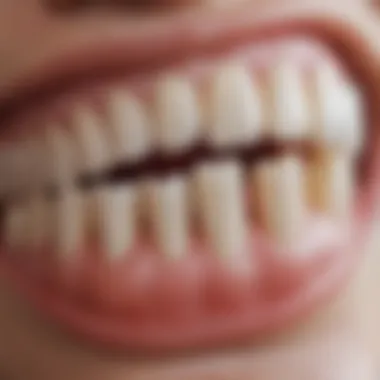Understanding White Stains on Teeth: Causes and Treatments


Article Overview
Purpose of the Article
This article aims to shed light on the common yet often misunderstood issue of white stains on teeth. These stains can pose both aesthetic and health concerns, making it essential to understand their origins, implications, and the various treatment options available. By providing a detailed exploration, we seek to inform readers about how to manage and prevent this dental condition effectively.
Relevance to Multiple Disciplines
The topic of white stains on teeth transcends mere cosmetic interests. It connects with various disciplines including dentistry, oral health education, and public health. Insights gleaned from this discussion are valuable not just for dental practitioners but also for patients who prioritize their oral well-being. Furthermore, researchers will find significance in the biological processes involved in enamel demineralization, contributing to the broader narrative surrounding dental health.
Research Background
Historical Context
The phenomenon of white stains on teeth has been documented for decades, though understanding has evolved over time. Historically, these stains were often attributed to poor dental hygiene. However, contemporary research highlights the multifactorial nature of their causation. Studies now indicate that factors such as dietary habits, specific medical conditions, and environmental influences play crucial roles in their development.
Key Concepts and Definitions
To frame the discussion, it is important to clarify key terms:
- Enamel Demineralization: This is a process where minerals are lost from the tooth's enamel, often leading to the appearance of white spots.
- Fluorosis: A condition caused by excessive fluoride exposure during tooth development, which can manifest as white stains.
- Hypoplasia: This refers to the incomplete development of dental enamel that can result in visible defects, including white spots.
Understanding these concepts will guide readers in appreciating the complexities surrounding white stains, emphasizing the need for informed dental care.
Prelims to White Stains on Teeth
White stains on teeth can often be a source of concern for individuals. They are commonly seen but not deeply understood. This topic is important because it encompasses various causes, implications, and treatments which directly affect oral health. By investigating these facets, we can arm ourselves with knowledge that affects both aesthetic outcomes and overall dental health.
Definition and Characteristics of White Stains
White stains are defined as areas on the tooth enamel that appear lighter than the surrounding surface. They can range from small dots to larger patches. These stains are often a sign of demineralization. They can be difficult to detect without proper examination, as they may not be immediately apparent, especially in individuals with light-colored teeth. Knowing the specific characteristics can aid in early identification.
Key Characteristics Include:
- Variations in size and shape
- Presence on both front and back teeth
- Color that varies from chalky white to off-white
- Formation that may be more visible when the mouth is dry
Understanding these characteristics is essential for diagnosis and further exploration of underlying causes.
Importance of Recognizing White Stains
Recognizing white stains on teeth is paramount for several reasons. Firstly, they can indicate a loss of enamel, which may lead to further dental problems if not addressed promptly. Moreover, the presence of these stains could be an early sign of conditions such as fluorosis or other developmental enamel issues. This awareness facilitates timely interventions, preventing cavity formation and other serious oral health issues.
- Aesthetic Concerns: Many individuals feel self-conscious about white stains, which may affect personal and professional relationships.
- Health Risks: Ignoring these stains can result in long-term damage, including increased susceptibility to decay.
- Behavioral Considerations: Early recognition encourages better dental hygiene habits, as individuals will likely seek knowledge and treatments to manage their oral health more proactively.
In summary, awareness and early recognition of white stains empower individuals to make informed decisions about their dental health.
In summary, awareness and early recognition of white stains empower individuals to make informed decisions about their dental health.
Types of White Stains
Understanding the different types of white stains on teeth is crucial for diagnosis and treatment. The classification primarily focuses on their origin, which can guide effective management strategies. Recognizing whether stains are intrinsic or extrinsic helps in determining the underlying causes and possible treatments. This insight is necessary not only for dental practitioners but also for patients seeking clarity on their dental issues, influencing choices in prevention and care.
Intrinsic White Stains
Intrinsic white stains originate from within the tooth structure, primarily affecting the enamel. These types of stains often stem from factors such as systemic diseases, genetic disorders, or exposure to excessive fluoride during early childhood. One common condition associated with intrinsic stains is dental fluorosis, which occurs when fluoride intake exceeds recommended levels during tooth development. This results in enamel that appears mottled or discolored.


Intrinsically stained teeth may also arise due to trauma that disrupts normal enamel formation. Such stains are typically more challenging to treat, as they are not merely on the surface. Patients experiencing intrinsic white stains often need professional evaluation to determine appropriate methods for improvement.
Extrinsic White Stains
Extrinsic white stains are those that develop on the surface of the teeth. They primarily result from external factors like dietary choices, oral hygiene practices, and lifestyle habits. Acidic foods and beverages, such as citrus fruits and sodas, can erode enamel, creating a suitable environment for enamel demineralization. Poor oral hygiene can further exacerbate this situation, allowing plaque and tartar buildup to cause additional staining.
Unlike intrinsic stains, extrinsic white stains are often easier to treat. Regular dental cleanings and improved oral hygiene can significantly reduce or eliminate these surface-level imperfections. Many individuals find that whitening toothpaste or over-the-counter whitening products can also help in minimizing the appearance of these stains effectively.
"Understanding the types of white stains on teeth can provide critical insights into effective treatment options."
"Understanding the types of white stains on teeth can provide critical insights into effective treatment options."
In summary, distinguishing between intrinsic and extrinsic white stains is essential for tailoring treatment approaches. Identifying the type of stain informs both practitioners and patients, contributing to better oral health outcomes.
Causes of White Stains
Understanding the causes of white stains on teeth is crucial for both prevention and treatment. These stains can indicate underlying issues in a person's oral health. Identifying the causes helps in selecting appropriate measures for treatment and in taking preventive steps. Educating oneself about these causes improves overall dental practices.
Fluorosis and its Impact
Dental fluorosis occurs due to excessive fluoride exposure during tooth development. It leads to discoloration characterized by white spots or streaks on the enamel. This condition stems primarily from high fluoride levels in drinking water or overuse of fluoride toothpaste in children. The degree of discoloration may vary, influenced by the amount and duration of fluoride exposure. Understanding fluorosis is essential because it highlights both preventive strategies and potential cosmetic concerns.
Acidic Foods and Beverages
Acidic foods and beverages can also contribute to white stains. Acidic drinks like sodas, fruit juices, and certain wines erode enamel. As enamel wears away, it exposes the inner layers of the teeth, potentially allowing minerals to leach out. This process leads to enamel demineralization, visibly manifesting as white spots. Being mindful of dietary choices helps prevent such damage and maintain enamel integrity.
Poor Oral Hygiene and Plaque Buildup
Maintaining proper oral hygiene is essential for dental health. Inadequate brushing and flossing can lead to plaque buildup. Plaque is a sticky film containing bacteria. If not removed, it hardens into tartar, which can cause discoloration. White stains often arise where plaque accumulates significantly. Thus, regular cleaning habits prevent the formation of stains and promote stronger enamel, highlighting the importance of consistent oral care routines.
Genetic Factors
Genetics plays a role in the prevalence of white stains on teeth. Some individuals are naturally predisposed to enamel defects. These defects can surface as white spots, indicating a more profound genetic condition. Recognizing such hereditary factors enables better tailored preventive measures and treatment options. Understanding genetic aspects helps individuals adapt their oral care practices effectively.
Implications of White Stains on Oral Health
White stains on teeth are more than just cosmetic issues. They can carry significant implications for oral health that merit examination. Understanding these implications is crucial for anyone concerned about their dental care.
Impact on Dental Aesthetics
Aesthetic concerns are often the first thing that comes to mind when white stains appear on teeth. They can create an uneven appearance that many may find displeasing. This might lead individuals to avoid smiling or showing their teeth, or even opting for social situations that require more confidence in their appearance.
Over time, patients may seek cosmetic treatments to mask or eliminate these stains. Options include professional whitening treatments, bonding, or even veneers. Yet, it is essential to note that the presence of white stains often indicates an underlying issue that needs addressing. Simply covering them up does not solve the problem.
In addition, individuals with white stains might experience varying reactions from peers, impacting personal and professional relationships. Neglecting the aesthetic implications can also lead to lowered self-esteem and feelings of insecurity about one's smile.
Potential for Tooth Decay
White stains can be a sign of demineralization of the enamel, indicating that the tooth's protective layer is compromised. This can escalate the risk of cavities.
When the enamel erodes, teeth become more susceptible to further decay. Bacteria can penetrate deeper into the tooth structure, leading to more significant health issues. Dental professionals often correlate white stains with active processes of decay, as the loss of minerals makes teeth weaker over time.
Proactive measures are vital in this context. For instance, strategies such as regular fluoride treatments can help to strengthen enamel and prevent further decay. The emphasis should not only be on cosmetic solutions but also on reinforcing overall oral health.
Psychological Effects
The appearance of white stains can lead to more than just physical changes; they can affect mental and emotional well-being. In many cases, individuals report feelings of embarrassment or anxiety related to their smiles. This can impact social interactions, job opportunities, and overall confidence.


Moreover, a study found that individuals with visible dental issues are sometimes perceived as less competent or trustworthy. This can create unwarranted barriers in both personal and professional environments.
Addressing the psychological implications of white stains is key. Encouragement to seek professional help can help individuals reclaim their confidence through treatment and improved oral hygiene practices.
In summary, while white stains may seem like a surface-level problem, their implications extend far beyond aesthetics. Understanding these effects is vital for a holistic approach to dental health.
In summary, while white stains may seem like a surface-level problem, their implications extend far beyond aesthetics. Understanding these effects is vital for a holistic approach to dental health.
Achieving a healthy smile requires more than mere appearance adjustments. It is essential to address the root causes, engage in preventive care, and seek appropriate treatments.
Preventive Measures Against White Stains
Preventive measures against white stains on teeth are crucial for maintaining dental health and aesthetics. The appearance of white stains often signals underlying issues that, if not addressed, can worsen over time. Understanding how to prevent these stains is central to both personal oral hygiene and professional dental practices. Essentially, preventative care is about recognizing factors that contribute to enamel demineralization and taking proactive steps.
Importance of Regular Dental Check-ups
Regular dental check-ups serve as a foundation for effective prevention of white stains. During these visits, dentists not only perform cleanings but also assess the health of your teeth and identify early signs of enamel issues. This early detection can significantly reduce the risk of more severe conditions.
- Importance of Professional Assessment: Dentists are trained to notice imperfections that may go unnoticed by patients themselves. They can advise on treatments or lifestyle adjustments tailored to individual needs.
- Customized Care Plans: Each person’s dental health is different. Regular check-ups allow for the development of personalized care plans that fit an individual's health profile and lifestyle.
- Education on Orla Hygiene: Dentists can provide valuable education regarding proper brushing and flossing techniques. This knowledge ensures that individuals can effectively minimize factors that contribute to white stains.
Role of Oral Hygiene Practices
Adopting rigorous oral hygiene practices is essential in preventing white stains. The foundation of maintaining a healthy smile relies heavily on daily care routines. Integrating key practices into one’s life can yield remarkable results.
- Brushing Twice Daily: This forms the first line of defense against plaque buildup, which can lead to staining. Use a fluoride toothpaste, as fluoride helps in remineralizing the enamel.
- Flossing Daily: Flossing removes food particles and plaque from between teeth, areas that a toothbrush cannot always reach. This practice is indispensable in preventing decay and discoloration.
- Using Mouthwash: An antibacterial mouthwash can help reduce harmful bacteria in the mouth, which can contribute to both plaque formation and potential stains.
By establishing a consistent oral hygiene routine, individuals can significantly diminish the risks associated with white stains.
Dietary Modifications
Diet plays a pivotal role in oral health and can either contribute to or prevent white stains on teeth. Certain foods and beverages can erode enamel over time, while others can help repair it. Smart dietary choices can enhance overall dental appearance and health.
- Limit Acidic Foods: Foods like citrus fruits, soda, and vinegar can wear down enamel. Limiting their consumption will help reduce the risk of stains.
- Avoid Sugary Beverages: Sodas and sweetened drinks not only contribute to tooth decay but also create an environment conducive to plaque growth. They should be consumed infrequently.
- Incorporate Dairy Products: Cheese and yogurt contain calcium and phosphates, which are beneficial for remineralizing teeth. Their regular consumption can strengthen enamel and potentially reverse early stages of decay.
- Drink Plenty of Water: Water, especially fluoridated water, helps rinse away food particles and keep the mouth hydrated, which is vital for maintaining enamel health.
"Dietary habits can remarkably influence both dental aesthetics and long-term health."
"Dietary habits can remarkably influence both dental aesthetics and long-term health."
Through thoughtful preventive measures and lifestyle adjustments, individuals can take significant strides toward protecting their teeth from developing white stains. Regular dental check-ups, solid oral hygiene practices, and mindful dietary choices collectively contribute to a healthier smile and preserved enamel integrity.
Treatment Options for White Stains
Understanding treatment options for white stains on teeth is crucial. These methods address both cosmetic concerns and underlying causes. Proper treatment not only enhances appearance but also contributes to overall oral health. Each option has benefits and specific considerations. It is important to choose a method that aligns with individual dental needs and conditions.
Whitening Treatments
Whitening treatments are popular among those who wish to improve dental aesthetics. They aim to reduce the visibility of white stains by lightening the surrounding enamel. Hydrogen peroxide and carbamide peroxide are common agents in many whitening products. These chemicals work to oxidize stains and brighten teeth.
However, it is critical to consult a dentist before starting any whitening regimen. Overuse can lead to enamel erosion or increased tooth sensitivity. Custom whitening trays from a dental professional can provide a more controlled approach, achieving better results while minimizing side effects.
Microabrasion Techniques
Microabrasion techniques involve removing a thin layer of enamel to diminish white stains. This method utilizes an abrasive material in combination with an acid to gently polish the surface of the teeth. It is most effective for superficial white stains, particularly those caused by fluorosis or enamel hypoplasia.
While this method can yield positive outcomes, it requires precision and expertise. A dental professional should conduct the procedure to ensure appropriate depth is maintained, thus protecting the underlying tooth structure. Post-treatment care is also essential to maintain results and prevent further staining.
Bonding and Veneers


Dental bonding and veneers are restorative options for more severe cases of white stains. Dental bonding uses a composite resin that adheres to the tooth surface. This approach can effectively mask stains, improving the aesthetic appearance. The process is usually completed in one visit, making it a convenient choice for many patients.
Porcelain veneers offer a more durable solution. These custom-made shells are designed to cover the front of the teeth, effectively hiding discoloration. While the initial investment is higher, veneers provide long-lasting results with proper care. Regular professional cleanings and good oral hygiene can enhance the lifespan of both bonding and veneers.
Enamel Remineralization Methods
Enamel remineralization methods are aimed at restoring minerals lost to enamel demineralization. Treatments often involve the use of fluoride varnishes or calcium phosphate paste. These substances help to replenish mineral content, strengthening the enamel and potentially reducing the appearance of white stains.
It is important to identify the underlying causes of enamel loss, such as dietary habits or oral hygiene practices. A dentist can recommend the best remineralization strategies, tailored to individual needs. Maintaining good oral hygiene is critical to support the efficacy of these methods and prevent further damage.
"Understanding the techniques and options for treating white stains enables individuals to take proactive steps towards improved dental aesthetics and health."
"Understanding the techniques and options for treating white stains enables individuals to take proactive steps towards improved dental aesthetics and health."
In summary, addressing white stains on teeth requires a multifaceted approach. Whitening treatments, microabrasion, bonding, veneers, and remineralization methods all serve different needs. Consulting a dental professional is essential for determining the most appropriate treatment based on individual circumstances.
Concluding Thoughts
The examination of white stains on teeth holds great importance in the context of dental health. These stains are not only cosmetic concerns but also indicators of deeper underlying issues that can impact oral health significantly. Understanding these stains, their causes, and implications informs better dental care practices and encourages individuals to seek early interventions.
Summary of Findings
This article has covered a variety of aspects regarding white stains on teeth. Key points include the distinction between intrinsic and extrinsic stains and the main causes that range from dental fluorosis to dietary habits. The implications of these stains extend beyond aesthetics; they can affect confidence and potentially lead to tooth decay if not addressed properly. Preventive measures and treatment options discussed shed light on ways to mitigate these stains while promoting overall dental health. Such findings underscore the need for comprehensive awareness of dental hygiene and regular dental visits, which play vital roles in maintaining tooth integrity.
Future Directions in Research
While existing studies provide foundational knowledge, further research is necessary for a deeper understanding of this topic. Future investigations could explore the biochemical mechanisms that contribute to the formation of white stains. Additionally, there is a need to evaluate long-term outcomes of current treatment methods. By focusing on innovative remediation techniques and preventive strategies, researchers can offer safer and more effective solutions. Advancements in the field will certainly assist both professionals and patients in managing and treating white stains effectively. Encouraging collaboration among dental researchers, health professionals, and patients will enhance the collective understanding and treatment of these common dental issues.
References and Further Reading
The inclusion of a references section is crucial in any scholarly article. It lends credibility to the information discussed and allows readers to delve deeper into specific aspects of the subject matter. In the context of white stains on teeth, the references and further reading section serves multiple functions.
First, it directs readers to some foundational texts and research articles that enhance their understanding of the underlying issues concerning tooth discoloration. By providing these resources, the article encourages an informed exploration of dental health, enabling individuals to grasp the complexities surrounding enamel condition and the factors leading to white stains.
Another important element is the accessibility of diverse viewpoints. The materials listed in this section reflect ongoing dialogues in dental academia. As research evolves, it is vital to consult respectable sources that can present current theories, methodologies, and findings related to dental aesthetics. This approach allows readers to assess various treatments, implications, and preventative measures based on the most recent literature.
Furthermore, readers can utilize these resources for practical purposes, such as figuring out personal dental care plans or understanding professional opinions on treatment efficacy. Incorporating the works of experienced professionals ensures that the content remains relevant and aligned with best practices in dental treatment.
"A well-rounded view on dental health is formed through varied sources, enriching personal insight into complexities that may not be easily grasped from a single narrative."
"A well-rounded view on dental health is formed through varied sources, enriching personal insight into complexities that may not be easily grasped from a single narrative."
Ultimately, the references section fosters an environment of proactive learning. It empowers readers—whether they are students, researchers, or dental professionals—to explore the topic of white stains comprehensively. This knowledge can lead to improved practices and increased awareness about maintaining oral hygiene.
Scholarly Articles
When diving into the realm of scholarly articles, it is important to focus on peer-reviewed research that sheds light on the clinical and biological aspects of white stains on teeth. Articles available through databases like 'PubMed' and 'Google Scholar' can offer insights into the mechanisms of enamel demineralization, elucidating how such processes lead to visible white stains.
- Articles may cover topics like:
- The role of fluoride in strengthening enamel
- Case studies examining patient outcomes after treatment for white stains
- Clinical trials assessing new treatment methodologies
By accessing these scholarly works, practitioners and interested readers can ensure they are utilizing evidence-based approaches in their understanding and treatment of white stains. The conclusions drawn from these research studies can directly inform clinical practices and help in raising awareness about oral health issues more generally.
Books and Reviews
Books and reviews provide a comprehensive resource for those wanting to delve deeper into dental health. They often synthesize a variety of studies and clinical experiences to present cohesive narratives on topics such as tooth aesthetics and treatment methods for stains.
Some areas covered may include:
- Texts focusing on dental materials that clarify efficacy and safety for treatments like bonding and whitening
- Reviews outlining demographic trends in the prevalence of white stains among different populations
- Guides advocating preventative practices, highlighting effective methods to counteract or avoid white stains on teeth
This depth of knowledge allows readers to build a more rounded understanding of how white stains affect not only aesthetics but also general dental health. These resources can help inform treatment decisions, providing a solid basis for developing effective dental care strategies.



